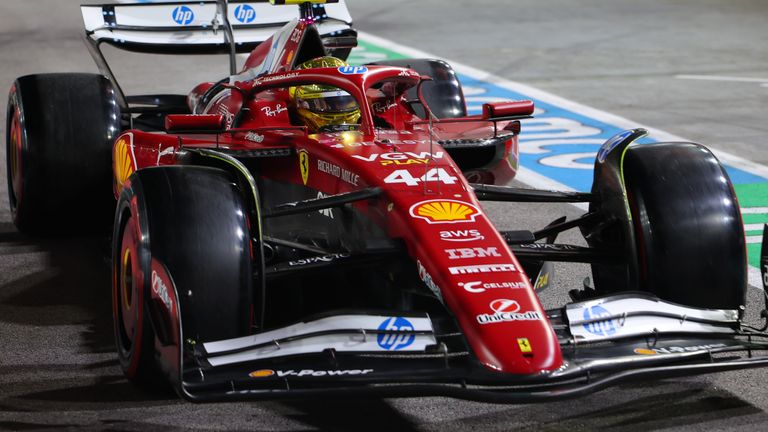The Singapore Grand Prix, a nocturnal spectacle under the city lights, rarely disappoints in delivering drama. This year, the final laps served up a particularly potent cocktail of mechanical failure, driver resilience, and a post-race penalty that stirred the ever-simmering pot of Formula 1 controversies. At its heart was Lewis Hamilton, his Mercedes battling a critical issue, and Fernando Alonso, a vocal observer who felt the scales of justice were, once again, tilted.
The Unraveling: A Brake Failure on the Brink
As the intense battle for position reached its crescendo on the unforgiving Marina Bay Street Circuit, Lewis Hamilton found himself in an unenviable predicament. His front brakes, pushed to their absolute limits, began to fail. In a desperate bid to salvage his race and nurse the crippled car home, Hamilton was forced to deviate from the pristine racing line, exceeding track limits on multiple occasions. It was a classic F1 scenario: a driver attempting to mitigate a catastrophic mechanical failure, pushing himself and his machinery beyond their intended parameters.
Hamilton`s choice of a two-stop strategy, utilizing soft tires for the final 16 laps, was an aggressive move aimed at making up ground. While it offered blistering pace, it undoubtedly contributed to the immense stress on his braking system. The irony, of course, being that his heroic effort to manage a damaged car ultimately led to a penalty rather than praise for his perseverance.

Alonso`s Outcry: A Call for Consistent Rules
Just behind Hamilton, closing in with characteristic tenacity, was Fernando Alonso. The seasoned Spaniard, no stranger to F1`s often-convoluted rulebook, witnessed Hamilton`s struggle and the resulting track limit breaches. His frustration, broadcast across team radio, was an unfiltered explosion of disbelief and a demand for consistency:
“I cannot f****** believe it. Is it safe to drive with no brakes? For me, you cannot drive when the car is unsafe. Sometimes they try to disqualify me with no mirror, and now you have no brakes and everything is fine? I doubt it.”
Alonso`s fiery commentary wasn`t just a heat-of-the-moment outburst; it was a pointed accusation of double standards. He vividly recalled past instances where he himself faced penalties for seemingly minor infractions, contrasting them with Hamilton`s situation where a severe safety issue seemed to be overlooked, at least initially. For Alonso, the principle was clear: if a car is compromised to the point of being unsafe, then irrespective of who is behind the wheel, the rules regarding safety and fair competition must apply equally and unequivocally. It`s a sentiment many fans, and indeed other drivers, often echo regarding F1 stewarding.
The Stewards` Stance: The Unbending Rulebook
The post-race investigation brought Hamilton and his team before the stewards. Hamilton readily admitted to straying beyond track limits, explaining the dire circumstances of his failing brakes. However, the stewards, guardians of the sporting regulations, remained unswayed by the mitigating factors. Their verdict: while acknowledging the brake issue, they determined it was “not a justifiable reason” for the infringements, and the standard five-second time penalty was applied.
This decision, while strictly adhering to the letter of the law, highlights a recurring tension in Formula 1. On one side, there is the human drama of a driver pushing limits and battling adversity; on the other, the technical rigidity of a rulebook designed for precise application. In Singapore, despite the mechanical empathy one might feel for Hamilton, the regulations ultimately left no room for sentiment, demoting him to eighth place and, perhaps poetically, elevating Alonso to seventh.
Hamilton`s Broader View: The Quest for Qualifying Perfection
Beyond the immediate penalty, Hamilton also reflected on the broader challenges facing his team, particularly in qualifying. He noted that while he had out-qualified his teammate, there was still “performance left on the table” over a single lap. This self-assessment underscores a critical aspect of modern Formula 1: the immense pressure to optimize every session, as a strong starting position on a tight circuit like Singapore can be half the battle won. His observations hint at the ongoing engineering puzzle that teams constantly face to find that elusive perfect balance.
Conclusion: A Legacy of Debate in the Lion City
The 2024 Singapore Grand Prix will undoubtedly be etched into the memory banks for its dramatic conclusion. Lewis Hamilton`s penalty, a direct consequence of a mechanical malfunction colliding with stringent track limit regulations, not only cost him positions but also ignited a passionate debate about consistency in stewarding. It was a stark reminder that in the high-stakes world of Formula 1, mechanical integrity, driver skill, and the meticulous application of rules all converge, sometimes in spectacular and controversial fashion. The pursuit of perfection on track is eternally intertwined with the pursuit of perfect officiating, and the latter, as Alonso so emphatically reminded us, remains a constant point of contention.

